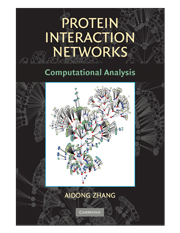Book contents
- Frontmatter
- Contents
- Preface
- 1 Introduction
- 2 Experimental Approaches to Generation of PPI Data
- 3 Computational Methods for the Prediction of PPIs
- 4 Basic Properties and Measurements of Protein Interaction Networks
- 5 Modularity Analysis of Protein Interaction Networks
- 6 Topological Analysis of Protein Interaction Networks
- 7 Distance-Based Modularity Analysis
- 8 Graph-Theoretic Approaches to Modularity Analysis
- 9 Flow-Based Analysis of Protein Interaction Networks
- 10 Statistics and Machine Learning Based Analysis of Protein Interaction Networks
- 11 Integration of GO into the Analysis of Protein Interaction Networks
- 12 Data Fusion in the Analysis of Protein Interaction Networks
- 13 Conclusion
- Bibliography
- Index
10 - Statistics and Machine Learning Based Analysis of Protein Interaction Networks
Published online by Cambridge University Press: 28 January 2010
- Frontmatter
- Contents
- Preface
- 1 Introduction
- 2 Experimental Approaches to Generation of PPI Data
- 3 Computational Methods for the Prediction of PPIs
- 4 Basic Properties and Measurements of Protein Interaction Networks
- 5 Modularity Analysis of Protein Interaction Networks
- 6 Topological Analysis of Protein Interaction Networks
- 7 Distance-Based Modularity Analysis
- 8 Graph-Theoretic Approaches to Modularity Analysis
- 9 Flow-Based Analysis of Protein Interaction Networks
- 10 Statistics and Machine Learning Based Analysis of Protein Interaction Networks
- 11 Integration of GO into the Analysis of Protein Interaction Networks
- 12 Data Fusion in the Analysis of Protein Interaction Networks
- 13 Conclusion
- Bibliography
- Index
Summary
INTRODUCTION
In recent years, the genomic sequencing of several model organisms has been completed. As of June 2006, complete genome sequences were available for 27 archaeal, 326 bacterial, and 21 eukaryotic organisms, and the sequencing of 316 bacterial, 24 archaeal, and 126 eukaryotic genomes was in progress [281]. In addition, the development of a variety of high-throughput methods, including the two-hybrid system, DNA microarrays, genomic SNP arrays, and protein chips, has generated large amounts of data suitable for the analysis of protein function. Although it is possible to determine the interactions between proteins and their functions accurately using biochemical/molecular experiments, such efforts are often very slow, costly and require extensive experimental validation. Therefore, the analysis of protein function in available databases offers an attractive prospect for less resource-intensive investigation.
Work with these sequenced genomes is hampered, however, by the fact that only 50–60% of their component genes have been annotated [281]. Several approaches have been developed to predict the functions of these unannotated proteins. The accurate prediction of protein function is of particular importance to an understanding of the critical cellular and biochemical processes in which they play a vital role. Methods that allow researchers to infer the functions of unannotated proteins using known functional annotations of proteins and the interaction patterns between them are needed.
Machine learning has been widely applied in the field of protein-protein interaction (PPI) networks and is particularly well suited to the prediction of protein functions. Methods have been developed to predict protein functions using a variety of information sources, including protein structure and sequence, protein domain, PPIs, genetic interactions, and the analysis of gene expression.
- Type
- Chapter
- Information
- Protein Interaction NetworksComputational Analysis, pp. 199 - 215Publisher: Cambridge University PressPrint publication year: 2009



